How Long Does It Take To Learn Git

by Iago Rodrigues
How you tin can learn Git and GitHub while you're learning to lawmaking

In this article, I'll requite you some hints well-nigh how to become a Git/GitHub ninja. Also, as a bonus, I'll show y'all how to employ the Terminal (beat) while coding. Then if you are a beginner, this post should assistance you empathise this tech. And if you lot already are a ninja, have a look through to assistance you remember things that you might take forgotten.
A brief intro
Git and GitHub are extremely important tools to our routine every bit a software developers. But, how can we acquire them as we have so much on our plates when we are learning code?
I'g Iago Rodrigues, a Brazilian. I'm a Systems Information educatee, a software developer intern, and a freelancer. I'm at the beginning of my career, and I wanted to share some knowledge that I've caused with you. So, become your coffee and let'south hack!
If you are a Portuguese reader, please go hither.
You can use this plan to study whatever programming language like JavaScript, Python, Node, and besides HTML and CSS. It doesn't matter what tech you lot are learning — versioning your work with Git is the default fashion to program.
Preparing the environment
Before nosotros outset, nosotros need to set up the surroundings to salve our code and examples of what we are learning.
To do this, we must complete some requirements:
- install Git on our machine
- create a GitHub business relationship
- create a workspace on our machine
If you lot've already done this, you can become straight to the GitHub'south workflow and the Terminal section.
Installing Git on your auto
Git installation is dissimilar on each operation system. Check out Git's official site to see which way is right for you.
Only if yous are using Windows (and speak Portuguese), I recommend this commodity.
Once Git is installed, we need to create a GitHub business relationship and configure it on our auto.
Creating an account on GitHub
To create an account, go to the GitHub spider web site and fill out the main grade.
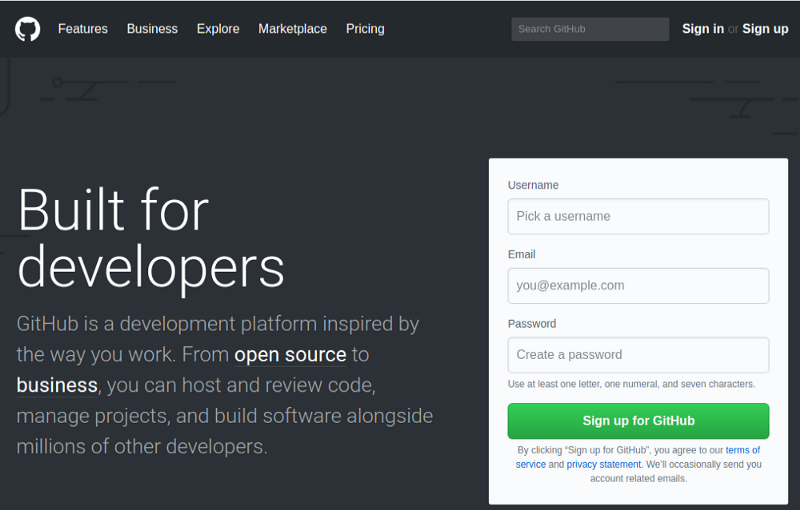
I recommend that you cull a real and nice user name here so you lot can use the account on résumés or your LinkedIn account.
You lot need to inform GitHub which plan you want to use. Choose the free selection. The only difference is that you can setup private repositories with the paid plan.
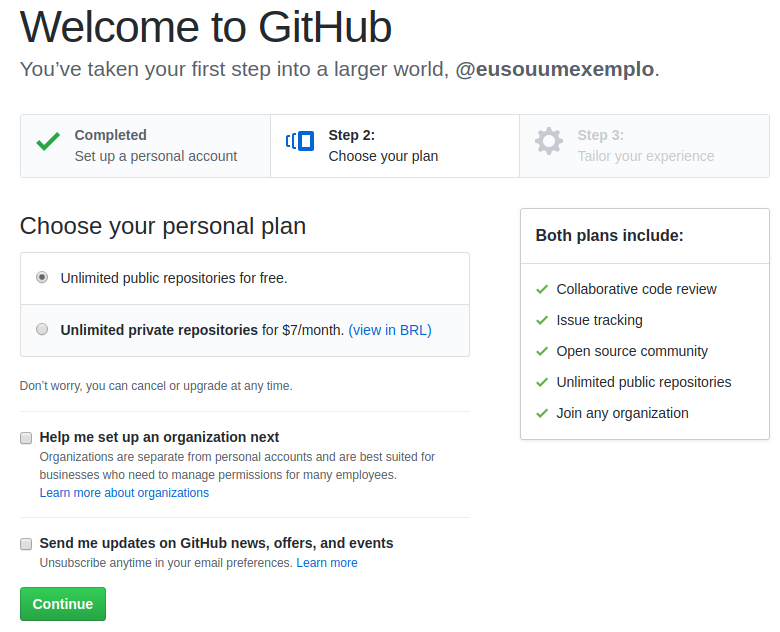
GitHub volition ask a few things before finishing your business relationship setup. You lot can answer them at present, or only jump to the next screen.
With everything completed, we can start our projection.
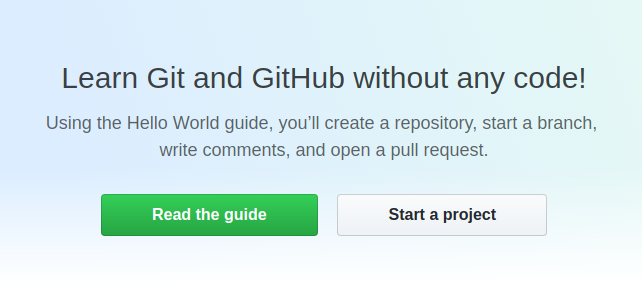
Earlier nosotros create our repository, though, let's setup our GitHub email and user name in our machine.
Setting up our system with our GitHub information
Open up your Terminal. In Windows, you have to open up the start menu and type cmd. Then click enter.
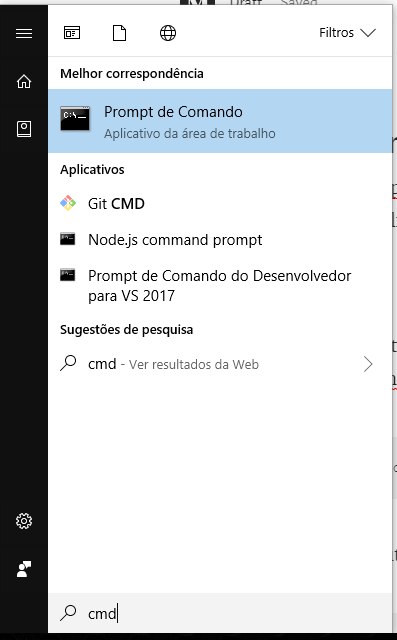
Or, you lot can install cmder (which is a skilful option) to apply it instead of cmd, which is the default Windows Terminal.
With that, we have to execute the following shell control in the cmder:
git config --global user.name "our_GitHub_user_name" Now put in your GitHub email address:
git config --global user.email "our_GitHub_user_email" Setting up your GitHub access key
Whenever you access a repository via shell, yous demand to have access permission. This is granted when you sign into your GitHub account. But, every time y'all send something to your repository (repo), you must pass your credentials.
To avoid this, employ an SSH key. This is an access key which GitHub exchanges with the one configured on our automobile.
To create this key, follow the process outlined in the GitHub documentation.
With all everything all configured, you lot are good to go!

GitHub's workflow and the Concluding
Let'due south set upwards a rule here:
Every fourth dimension you create a project to study something, such as making an HTML page or a control line game with Node.js or anything, y'all'll create a repository, clone it in your machine, piece of work on it using branches, and brand small commits to transport to GitHub.
Deal?!
This will guarantee that you lot get some experience which you'll need to master these tools.
So allow'southward get started.
Create a new projection
Permit's get back to your GitHub page and click on the plus icon (+) at the superlative of the page.
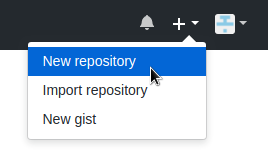
Click on New repository.
Let's say you are creating a project to study HTML, so name your repository learning-html. It could be the name of a page that is beingness created or whatever project, such as: curriculum-in-html, trivial-ophidian, tic-tac-toe , or anything else, ok?
The description of the project is optional. But I think it'south important to enter some helpful text there, every bit it volition place the scope of your projection. If other people want to assist you, they can understand your project briefly through the clarification. In your case, you can enter something like HTML linguistic communication written report repository.
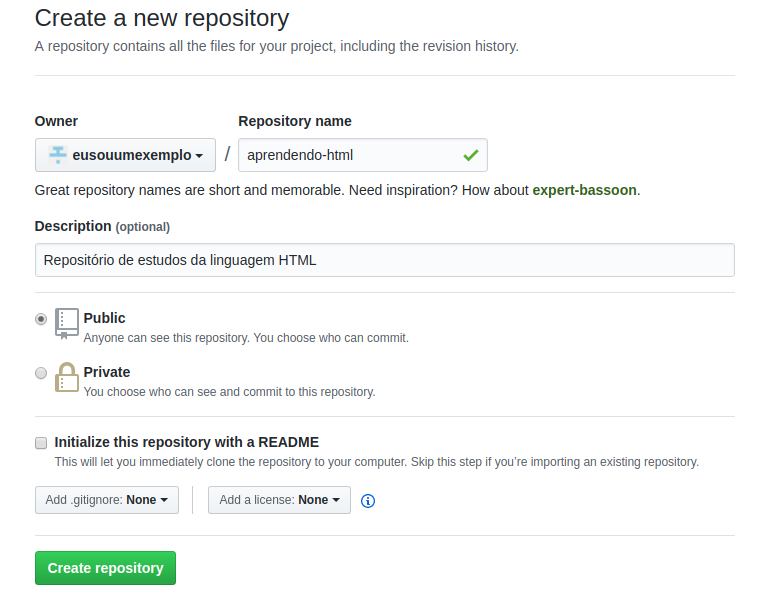
Yous should brand a README file besides, and define the type of license that you will use in the projection. Take a look at these good examples of READMEs, likewise as the license to use on the projection.
The README file is a more complete clarification of your project, so it's a good idea to put some helpful data in at that place. Follow the examples in the link.
Although the license is optional, it's expert exercise to define it. The license will say what other people can practice with your code. The MIT license is one of the most pop, and allows you (and others) to do many things with the project. Take some time to search for others types of licenses if yous wish.
Create your workspace
Once you've created the repository, you lot can clone it on your machine. But before that, you lot need to create a binder where yous will clone all futurity repositories you work on.
Use the last to create a folder that will be your workspace. Y'all exercise this to maintain an organized system, otherwise you lot'll end upwards scattering your projects around (and y'all might lose them only like you lost those kittens gifs that you lot saved on your computer…).
Assuming that you've already installed cmder, we can now open it (if you didn't, now is a proficient fourth dimension) and we will be at C:/Users/your_computer_name .
If you aren't on this path, employ the command:
cd %home% Run the command mkdir folder_name to create the workspace. For example:
mkdir workspace That'southward information technology! Now you accept the default folder for your projects, and you tin can clone your repositories in there.
Clone your repositories
Cloning a repository means that you'll copy all of the files and directories on the GitHub server onto your machine so y'all tin can work with them.
Now you need to clone the projection that you created on GitHub to your workspace. To do this, go to the binder that you just created. On cmder, type:
cd workspace\ Tip: if y'all created the binder or want to access one which already exists, yous tin starting time typing its name and hit TAB, and cmder volition autocomplete the name for yous.
With that, go to your project page on GitHub and get the link that y'all need to clone the repository.
The link is in that green push named Clone or Download:
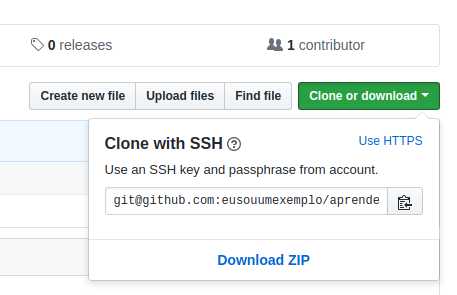
Alter from HTTPS to SSH, because you already configured your access key in your account.
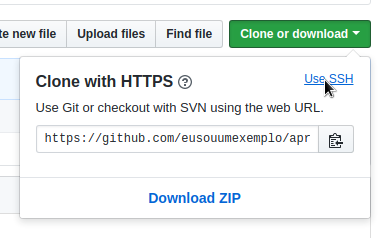
Now you tin run the git clone control and laissez passer the link that y'all go. Just like that:
git clone git@github.com:our-username/learning-html.git And your repository will be cloned, like in the following picture:

You can admission the repository folder which was created in your workspace when you cloned information technology.
Blazon the command: cd learning-html/
Attention: I'm bold that you are within theworkspace diretory at present. If you aren't, the above control will non work. Utilise cd %dwelling%\workspace\ and then the above command.
Create a co-operative
Every time you change something in a projection versioned with Git, you should create a branch with the proper noun of the chore which you lot're working on. This prevents you from messing up the "master" code located on the master branch. For this, you can use the following command:
git checkout -b task_name A branch is like a tree branch. It'southward office of the trunk of the tree. So you lot can make changes in parallel with the main part of the project without affecting it.
For example:

Once you've done this, you can change automatically to the newly created branch and can code like crazy at present.

Commit the changes
One time you lot stop a change to your project, you lot should commit the modify to your remote repository (the one on GitHub'due south servers).
To commit something is to tell Git that you are putting your changes in the queue to be pushed (sent) to your remote repository.
Imagine that you only created an HTML page and added some titles and text to information technology. You have the first version of this document now, so you should commit it.
To do this, run some commands and then that Git understands that we want to send our changes practice the remote repo. Run git add file_name to tell Git to stage the file.
Alternatively, yous tin can run git add --all to transport all the files that you lot fabricated some changes to. With the git status control, you can come across which inverse files you lot will commit to the server.
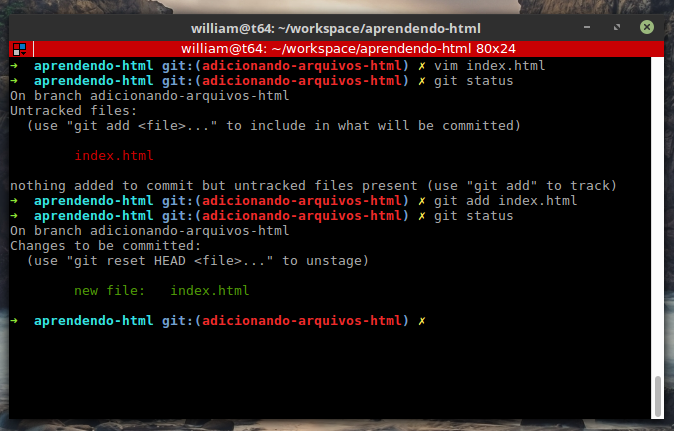
In the above example, the alphabetize.html file was created and the git status control was run to see what was inverse. Then the file was added with git add and git status was run once again to see which file was added to the Git workspace.
With that you tin at present commit the changes. Just run the git commit control, just like git commit -m "commit_message" . Call back to include a descriptive message of what was added to the commit.
Merging the changes
After y'all've committed the changes, you lot now accept a branch with modifications ahead of the ones in the principal co-operative. That means that you lot have a different version of the project, and you need to merge those changes with the main version of the project. Earlier doing that, verify what the differences are between the branches. On your branch, perform the command:
git diff master The output volition be something like:
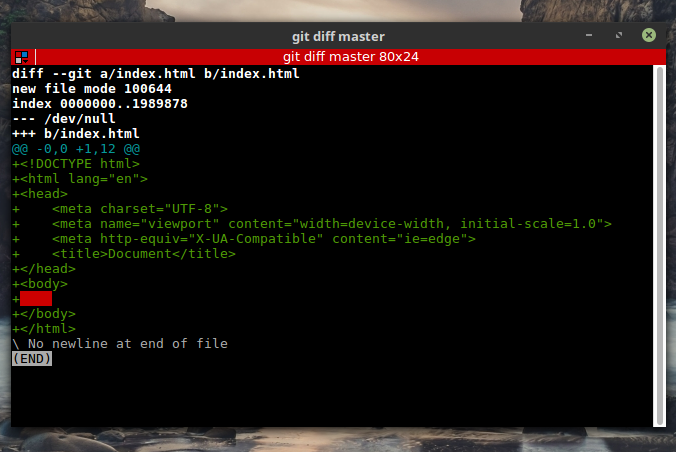
Git shows yous the newest commit made, which files were added or inverse, and what was changed as well.
Since you know that you have differences between your branch and the master, you need to merge them to join the new commits, which you fabricated in your branch, with the code in the master. To exercise this, you need to go to the master co-operative, on cmder, and run the command git merge .
To get back to the chief, run git checkout master . To merge the commits, run git merge our_branch_name .
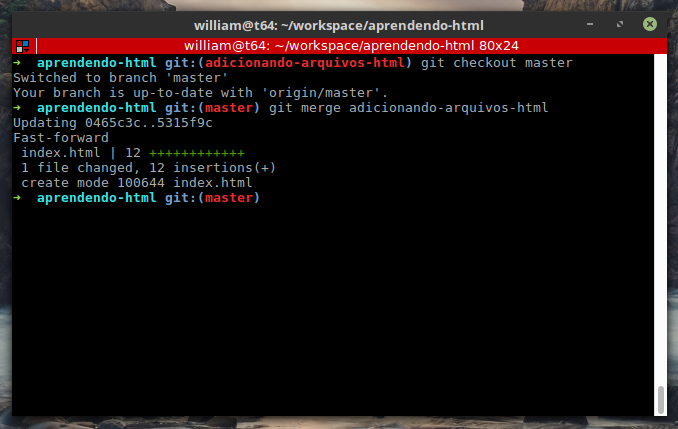
Git will show you an output confirming what was added.
Sending it to GitHub
After you lot've made and merged all the changes, y'all can now send them to your remote repository on GitHub.
Yous volition use git push origin master to practise this.
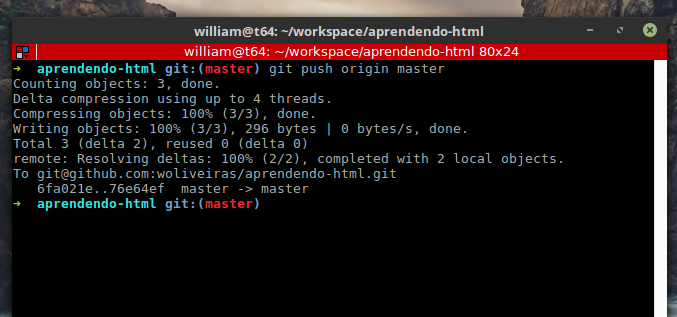
Yous can besides only apply git push . It'll have the same outcome. Merely when y'all push changes for the first time on your workspace, y'all need to practise git push button origin primary so that Git volition know that your workspace is the origin of the push button.
At present your commit will appear on your GitHub repository's folio:
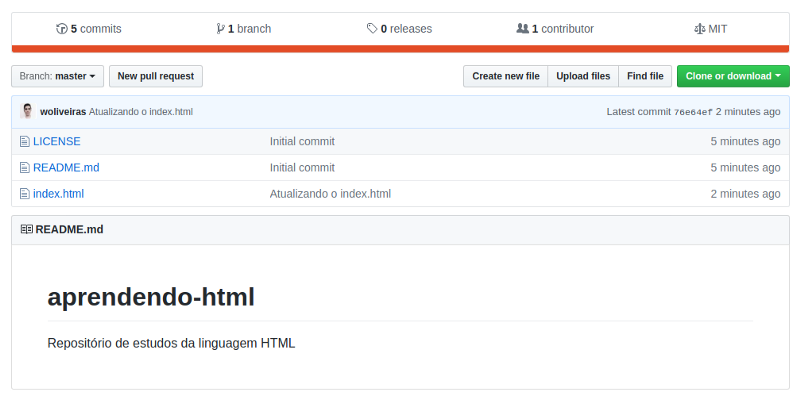
Conclusion
In this tutorial, you learned how to create a project on GitHub so that you can track your progress every time y'all study something new. This will help you get to know the command line (Last), Git commands, and GitHub. Besides that, it'll help y'all create a nice portfolio that y'all can bear witness in job interviews.
Practicing like this will also help you better sympathise how to use Git with remote repositories (the repositories hosted on some platform like GitHub). You'll also level upwards your knowledge and skills on the Terminal.
Don't forget the ground rules that you set:
- always create a new project of report
- work on branches
- commit the changes until it's fourth dimension to push them to GitHub
Ok? :)
Come up back here and follow this step-by-stride guide every time y'all forget something!
My proper noun is Iago Rodrigues. I am an intern in Brazil, in the city of Belem.
You can follow me on social media. Always a pleasure to assistance with what I tin can.
Iago Rodrigues (@iagokv) | Twitter
The latest Tweets from Iago Rodrigues (@iagokv). Front-End Programmer | Vue.js padawan | Noob on life. Belém, Brasiltwitter.com
Yep! I know. My twitter photograph is something …
Acquire to code for free. freeCodeCamp's open up source curriculum has helped more than 40,000 people get jobs every bit developers. Get started
Source: https://www.freecodecamp.org/news/how-you-can-learn-git-and-github-while-youre-learning-to-code-7a592ea287ba/
Posted by: taylorwhick1956.blogspot.com


0 Response to "How Long Does It Take To Learn Git"
Post a Comment